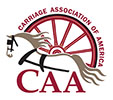Q) The show season ends and we usually just throw everything off the truck after the last show and don’t look at it again until we get ready for the show season the next spring. We stick the buggy in a corner of the garage where it gets sort of grimy. I know we should be doing it differently but no one has ever told us what we should be doing. Can you give us some suggestions about winter storage?
A) You need not feel alone in your being somewhat distressed at the apparent lack of direction about winter storage. Other than the advice about running a stable found in such books as Garland’s The Private Stable, there really isn’t a lot of material in print about it.
One of the reasons for this is that there are wide differences in the types of storage space provided. Just taking into consideration the climatic differences across this country accounts for some difference in the advice tendered. For instance, the dry climates of New Mexico and Arizona would require a different humidification program than the dehumidifiers required by Maine or New Jersey where the seacoast is near. Extreme dryness can be as damaging as extreme dampness. One has to take into account the location of the carriage house.
Generally speaking, a good plan of year-end maintenance would be:
- Remove the wheels, and clean all the axle ends and the nuts. Inspect for excessive wear and look for any scarring of the metal shank. Replace the worn leather grease holder, if any. Grease and replace wheels, but remember that most English-type carriages were made for heavy gear oil and not grease, so it is always a good idea to check the type of axle before applying lubrication. A general rule of thumb is that the mail and collinge axles should be lubricated with gear oil. Study the axle; if there is a reservoir somewhere within the hub, it should be oiled.
- Set the carriage up on blocks. Do not let it just stand there until April or May. The wheels will tend to lose their trueness and rubber will develop flat spots. If, of course, you move the carriage around regularly, you need not block it up.
- Vacuum all the cushions and rugs, checking behind the seat cushions for accumulated dirt or debris. Spray the trim (upholstery) with a moth repellent. If you regularly check your vehicles, do not cover. Mice love covered places and bagged cushions. The more openly the vehicles can be kept, the safer.
- Make sure that any light source is filtered. Sunlight will cause paint to fade and cause the upholstery to deteriorate: it needs to be screened.
- Wash the carriage off with lukewarm water and a clean sponge. Use water sparingly and do not drench. Wood and water do not mix. Use a separate sponge for wheels where grit and bits of sand particles cling. Be careful not to drag these over the painted panels and scratch them. Dry the carriage off with a clean chamois. Dust the carriage periodically during the winter months.
- Develop a plan to check each carriage regularly and thoroughly.
- Get major repairs done early. Remember, your fellow competitors will be looking to get their carriages done in time for the same spring show season.
- Make a resolution to keep your carriage “road ready” and do not let it become a storage place for headstalls, rubber boots, and brushes that have no home of their own.
- CLEAN THE HARNESS. Probably the number one fault among carriage people is failure to clean the harness. Do not just hang it up until you have to clean it for a show. Above all, do not hang it where the dampness invites mildew.
Doubtless there are some other things one ought to do, and there are probably some better ways to manage all this. Whatever you choose to do, do it regularly.
K.W.
Originally printed in The Carriage Journal, Spring 1993, Vol. 30, No. 4
This video (not in English) is a good visual reference on how to lubricate a collinge axle.


